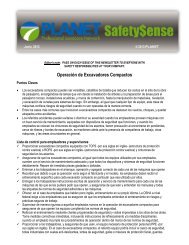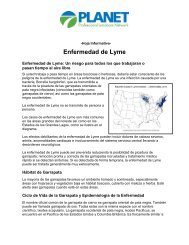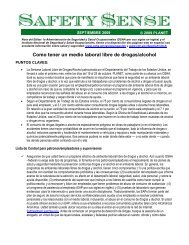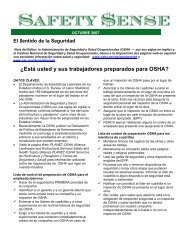Economic Impacts of the Green Industry in the - Urban Forest ...
Economic Impacts of the Green Industry in the - Urban Forest ...
Economic Impacts of the Green Industry in the - Urban Forest ...
You also want an ePaper? Increase the reach of your titles
YUMPU automatically turns print PDFs into web optimized ePapers that Google loves.
floriculture and nursery stock imports. The share <strong>of</strong> imported cut flowers <strong>in</strong> total U.S. cut flower supply was 56<br />
percent as recently as 2002. It is anticipated to jump to 63 percent <strong>in</strong> 2004. The number <strong>of</strong> cut flower producers <strong>in</strong><br />
<strong>the</strong> United States was at a record low <strong>of</strong> 548 <strong>in</strong> 2003, down from 618 <strong>in</strong> 2002, and is expected to dw<strong>in</strong>dle fur<strong>the</strong>r.<br />
Despite fewer producers, average cut flower sales per U.S. grower have been grow<strong>in</strong>g and now approach<br />
$780,000 as <strong>the</strong> size <strong>of</strong> operations has expanded. By rank order, <strong>the</strong> largest average sales <strong>of</strong> growers are <strong>of</strong> roses<br />
($701,000); gladioli, gerbera daisies, lilies (all around $500 million); and tulips and chrysan<strong>the</strong>mums (both about<br />
$300 million). In average unit prices, <strong>the</strong> leaders are pompon mums at $1.32 per bunch, orchids at $0.70 per<br />
bloom, and lilies at $0.64 per stem.<br />
Sales <strong>of</strong> potted flower<strong>in</strong>g plants are forecast at $820 million and foliage plants at $616 million <strong>in</strong> 2004, down<br />
slightly from $829 million and $623 million, respectively, <strong>in</strong> 2003 (USDA, NASS). Competition from fastgrow<strong>in</strong>g<br />
imports, especially from Canada, and crop damage from hurricanes <strong>in</strong> Florida will dampen sales<br />
prospects <strong>of</strong> domestic growers. Imports <strong>of</strong> orchid plants are also ris<strong>in</strong>g from Taiwan, Thailand, <strong>the</strong> Ne<strong>the</strong>rlands,<br />
South Korea, and Canada. Never<strong>the</strong>less, domestic grower sales <strong>of</strong> potted flower<strong>in</strong>g plants per U.S. household<br />
have held steady at between $7 and $8, and between $5 and $6 for foliage plants, over <strong>the</strong> past decade. Florida<br />
dom<strong>in</strong>ates <strong>the</strong> foliage plant market, captur<strong>in</strong>g 64 percent <strong>of</strong> total U.S. value <strong>in</strong> 2003. Prices <strong>of</strong> potted flower<strong>in</strong>g<br />
plants have risen 6 percent on average s<strong>in</strong>ce 2000, reflect<strong>in</strong>g healthy demand for high-value varieties such as<br />
florist roses, florist azaleas, and spr<strong>in</strong>g flower<strong>in</strong>g bulbs. Even prices <strong>of</strong> po<strong>in</strong>settias, which account for 30 percent<br />
<strong>of</strong> total receipts from potted flower<strong>in</strong>g plants <strong>in</strong> 2003, were up <strong>in</strong> <strong>the</strong> last two years. Prices <strong>of</strong> potted orchids,<br />
however, appear to be <strong>in</strong> a downward trend s<strong>in</strong>ce 2000. The quantity <strong>of</strong> potted orchids sold jumped from 9.7<br />
million <strong>in</strong> 2000 to 15.6 million <strong>in</strong> 2003, <strong>in</strong>dicat<strong>in</strong>g <strong>in</strong>creas<strong>in</strong>g supply. Although producers boosted domestic<br />
orchid production, imported orchid plants have grown 70 percent <strong>in</strong> volume s<strong>in</strong>ce 2000, provid<strong>in</strong>g ample<br />
competition to local growers.<br />
Bedd<strong>in</strong>g and garden annuals dom<strong>in</strong>ate U.S. floriculture sales, compris<strong>in</strong>g 36 percent <strong>of</strong> <strong>the</strong> $5.1 billion sales <strong>of</strong><br />
floral crops <strong>in</strong> 2003 (UDA-NASS). Toge<strong>the</strong>r with herbaceous perennial plants, <strong>the</strong> share is boosted to 48 percent.<br />
And s<strong>in</strong>ce this sector posted a 1-percent sales ga<strong>in</strong> <strong>in</strong> 2003, compared with decl<strong>in</strong>es <strong>in</strong> cut flowers, potted<br />
flower<strong>in</strong>g plants, and cut cultivated greens, it was enough to push total floriculture receipts up. This growth is<br />
expected to repeat <strong>in</strong> 2004 as total bedd<strong>in</strong>g and garden receipts reach at least $2.424 billion, up $23 million from<br />
2003. Sales <strong>of</strong> bedd<strong>in</strong>g and garden annuals are forecasted at $1.823 billion <strong>in</strong> 2004, cont<strong>in</strong>u<strong>in</strong>g annual ga<strong>in</strong>s s<strong>in</strong>ce<br />
2000. Herbaceous perennial sales are also projected up, exceed<strong>in</strong>g sales <strong>of</strong> foliage plants for <strong>the</strong> first time and<br />
becom<strong>in</strong>g <strong>the</strong> second largest segment/product group <strong>in</strong> <strong>the</strong> <strong>in</strong>dustry. It is evident that growers are <strong>in</strong>creas<strong>in</strong>g<br />
production <strong>of</strong> annuals and perennials relative to o<strong>the</strong>r floriculture crops, more significantly <strong>in</strong> <strong>the</strong> Midwest and<br />
Nor<strong>the</strong>ast. Sales <strong>of</strong> annuals <strong>in</strong> flats were down <strong>in</strong> 2003 while potted annuals and hang<strong>in</strong>g baskets registered ga<strong>in</strong>s.<br />
Although floriculture sales per U.S. household will cont<strong>in</strong>ue to decl<strong>in</strong>e, albeit marg<strong>in</strong>ally, per household sales <strong>of</strong><br />
bedd<strong>in</strong>g and garden plants are expected to rema<strong>in</strong> at just over $22, unchanged s<strong>in</strong>ce 2002. Prices <strong>of</strong> bedd<strong>in</strong>g and<br />
garden plants have been noticeably stable s<strong>in</strong>ce 2000 as sales growth is matched by <strong>the</strong> pace <strong>of</strong> quantity produced.<br />
This price pattern is <strong>the</strong> effective average between weak prices <strong>of</strong> annuals and ris<strong>in</strong>g prices <strong>of</strong> perennials s<strong>in</strong>ce<br />
2001. For annuals, prices <strong>of</strong> potted plants and hang<strong>in</strong>g baskets show a slight upward slope <strong>in</strong> contrast to<br />
downward prices <strong>of</strong> bedd<strong>in</strong>g and garden plants <strong>in</strong> flats. Increased production <strong>of</strong> bedd<strong>in</strong>g and garden annuals <strong>in</strong> <strong>the</strong><br />
Midwest is supported by higher overall prices. But production <strong>of</strong> herbaceous perennials, except potted<br />
hardy/garden mums, is shift<strong>in</strong>g heavily to Sou<strong>the</strong>rn States, specifically South Carol<strong>in</strong>a.<br />
U.S. ORNAMENTAL IMPORTS<br />
Expected prices for imported cut flowers are up 10 percent, due <strong>in</strong> part to <strong>the</strong> weaker U.S. dollar and higher fuel<br />
costs for transport (USDA-NASS). U.S.-grown cut flower prices are up 3 percent, due also <strong>in</strong> part to higher fuel<br />
and energy costs and damage to cut flower production by hurricanes <strong>in</strong> late summer. Import prices <strong>of</strong> cut flowers<br />
<strong>in</strong> 2004 are 15 percent higher than <strong>in</strong> 2000, after <strong>in</strong>itially dropp<strong>in</strong>g 5 percent <strong>in</strong> 2002. Cut flower imports fell <strong>in</strong><br />
2001 and 2002 due to weak U.S. demand which was precipitated by <strong>the</strong> economic recession and stock market<br />
downturn. The share <strong>of</strong> imports <strong>in</strong> U.S. cut flower consumption is projected at a record 65 percent, up from 61<br />
percent <strong>in</strong> 2003. In 1992, <strong>the</strong> import share was 20 po<strong>in</strong>ts lower at 45 percent. The quantity <strong>of</strong> imported flower<strong>in</strong>g<br />
and bedd<strong>in</strong>g plants, largely from Canada, are expected to be up 8 percent <strong>in</strong> 2004 based on strong shipments from<br />
January to July. However, lower prices for imported flower<strong>in</strong>g, bedd<strong>in</strong>g, and foliage plants push <strong>the</strong> import value<br />
down somewhat from 2003. N<strong>in</strong>ety-four percent <strong>of</strong> U.S. imported cut flowers are from Colombia, Ecuador, <strong>the</strong><br />
Ne<strong>the</strong>rlands, Mexico, Canada, and Costa Rica. Cut flower imports are dom<strong>in</strong>ated by roses at 35 percent <strong>of</strong><br />
12
















